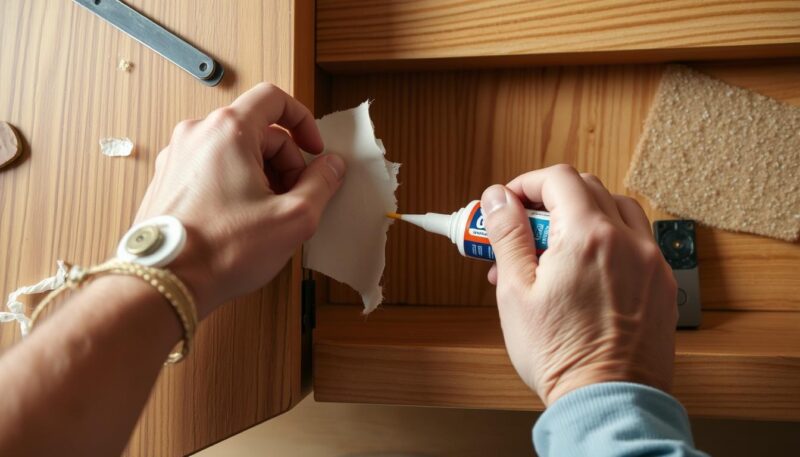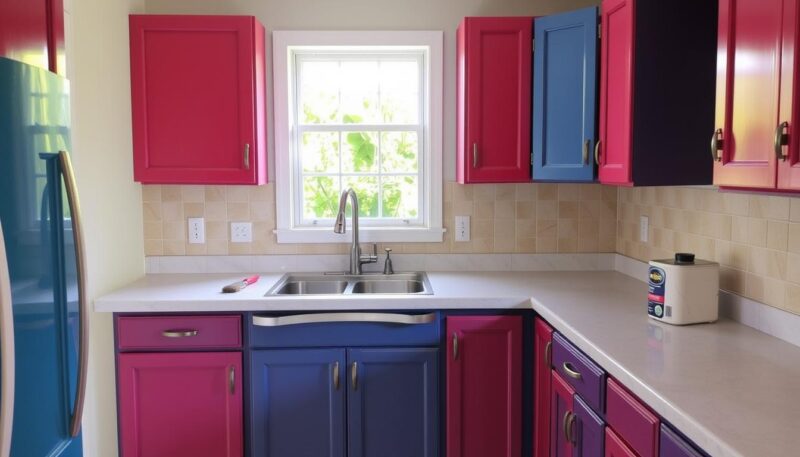Peeling laminate cabinets are a common sight in homes, especially those boasting builder-grade units that have served you well for a couple of decades. The dilemma of how to repair peeling laminate cabinets can be quite a bothersome journey. These cabinets, although functional, eventually show signs of wear and tear. You might dream of a completely revamped kitchen, but budget-friendly solutions are often the more practical route to take.
Instead of breaking the bank on a full remodel, you can explore savvy DIY cabinet repair methods that breathe new life into your old kitchen setup. This is where quick fixes and laminate restoration techniques come into play. DIY methods offer numerous budget-friendly solutions that can effectively handle peeling concerns without compromising the aesthetics of your kitchen.
Altogether, laminate cabinets are the heroes of affordability and style, making them a favored choice for both bathrooms and kitchens. Yet, over time, they face their trials, leading many to ponder whether to repair or replace them. If you’re facing this peeling issue and wondering what steps to take next, you’re not alone.
It’s crucial to understand the causes behind this peeling issue. Whether it’s due to moisture, heat, or simple age, knowing the root cause helps in executing a more effective fix. Evaluating the damage is also essential to decide between repair and replacement, setting the stage for you to understand the basics of laminate materials and the repair process. This guide promises a detailed walkthrough, from evaluating the damage to completing the repair.
In the sections that follow, we’ll delve deeply into the essentials of DIY cabinet repair methods, highlight specific materials such as Kilz spray primer and Sherwin-Williams ProClassic Waterborne Interior Acrylic Enamel, and offer you step-by-step guidance on how to tackle peeling laminate effectively. Join us on this journey to discover actionable tips that can transform your kitchen into a space you’ll love.
Understanding the Peeling Issue
Understanding the peeling issue of laminate cabinets is crucial before diving into repairs or replacements. This section covers common causes of peeling, evaluating the damage, and making the repair or replacement decision. By grasping these aspects, you can avoid common mistakes and ensure a more successful fix.
Common Causes of Peeling Laminate
Laminate cabinets, particularly thermofoil ones, are prone to peeling due to several factors. Thermofoil cabinets employ a thin layer of PVC material in the thermofoil process, making them more susceptible to delamination. Environmental factors like high humidity, as well as high-traffic areas, can accelerate the peeling process. Peeling is often observed in areas above heat-generating appliances such as coffee makers and toasters.
- Age and Wear: Laminate can start peeling after a few years of use, especially in high-traffic and high-moisture areas.
- Environmental Factors: Exposure to heat and humidity can cause the adhesive to weaken, leading to delamination.
- Material Quality: Thermofoil cabinets, though popular for their affordability, are more prone to peeling compared to higher-quality wood veneer cabinets.
Evaluating the Damage
Before deciding on whether to repair or replace, evaluating laminate damage is a critical first step. Assess if the peeling is minor, such as a few edges lifting, or significant, like entire sections detaching. Note if the MDF core underneath the thermofoil is damaged or warped, as this affects repair feasibility.
| Damage Type | Repair Needs | Replacement Considerations |
|---|---|---|
| Minor Peeling | Re-gluing edges | Not necessary |
| Significant Peeling | Possible regluing, but may face recurring issues | Consider replacing laminate or entire cabinet |
| Warped MDF Core | Not recommended for repair | Replacement of damaged parts |
Deciding Between Repair or Replacement
Making the repair or replacement decision hinges on several factors. If the peeling is localized and the materials needed for repair are minimal, gluing and clamping the affected area can be an efficient fix. However, for widespread peeling or damaged cores, replacing the cabinets or installing new fronts might be more effective. Consider the cost, time, and final aesthetics when making your decision.
- Minor Damage: Quick fixes like re-gluing can suffice.
- Major Damage: Replacement may offer a longer-lasting solution.
- MDF Core Issues: Opt for replacing damaged parts rather than repairing.
By understanding laminate types and correctly evaluating the damage, you can significantly minimize errors and make an informed repair or replacement decision. Follow these guidelines to ensure your cabinets look as good as new for years to come.
How to Repair Peeling Laminate Cabinets?
Repairing peeling laminate cabinets might seem daunting at first, but it’s achievable with the right approach. Here’s a comprehensive guide for a DIY fix, ensuring you save both time and money while preventing future peeling.
Materials Needed
- Spackling knives
- Sandpaper
- Paint and primer
- Contact cement
- Scrap wood and C-clamps
- Lacquer thinner containing methyl ethyl ketone
Step-by-Step Repair Process
- Remove the cabinet door for a more controlled environment.
- Gently peel off the loose laminate, ensuring not to damage the core.
- Clean and sand the core to prepare the surface.
- Apply contact cement to both the core and the back of the laminate. Allow it to set for about ten minutes.
- Carefully press the laminate onto the core, ensuring a firm bond.
- Clamp the surfaces together using scrap wood and C-clamps for about five minutes.
- If any glue oozes, use lacquer thinner to clean it up.
- Once the glue is fully set, sand any rough edges and apply primer followed by paint for a smooth finish.
Safety Precautions
Your safety is paramount. Follow these safety precautions to ensure a hazard-free repair process:
- Work in a well-ventilated area to avoid inhaling fumes from glues and thinners.
- Wear protective gloves to handle chemicals and avoid skin contact.
- Use a mask to prevent respiratory issues from dust while sanding.
- Ensure all tools for repair are in good working condition to prevent accidents.
Tips for a Successful Fix
Achieving a long-lasting fix requires some maintenance tips and understanding of the materials:
- Preventing future peeling: Choose high-quality primer and paint to withstand daily wear and environmental factors.
- Steps for a successful fix: Ensure thorough cleaning and sanding before re-gluing. Proper clamping is essential for a strong adhesive bond.
- Consult expert opinions or tutorials if you’re unsure about any steps.
- Post-repair, regularly inspect and maintain your cabinets to prolong their lifespan. Avoid placing heat-generating appliances near the cabinets to minimize the risk of future peeling.
By following these guidelines, you can ensure a seamless and durable repair of your peeling laminate cabinets, boosting their longevity and maintaining their aesthetic appeal.
Conclusion
Repairing peeling laminate cabinets yourself is a cost-effective and satisfying solution for rejuvenating your kitchen. By understanding common issues such as peeling laminate due to moisture exposure, and following a well-planned approach, you can achieve noticeable transformations. Whether you address peeling, loose hinges, scratches, or water damage, each step you take in DIY repair significantly impacts your kitchen’s overall appearance.
Employing the right materials and techniques, as discussed in this article, ensures a successful fix that not only enhances the durability of your cabinets but also saves you a considerable amount of money. Before and after examples can serve as motivation, showcasing the dramatic improvements that result from investing time and effort into these repairs. Remember, the time investment varies depending on the extent of the damage, but the results are undoubtedly worth it.
Painting options can also add a fresh perspective to your kitchen. By choosing the right colors and finishes, you can revitalize your space without the hefty price tag of a full renovation. Follow our guidelines to ensure a smooth and professional finish. Embrace preventive maintenance to keep your cabinets in prime condition, and enjoy the benefits of a well-maintained and aesthetically pleasing kitchen.


